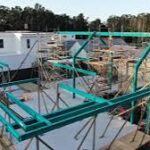Overview
Fire safety remains a critical priority in construction, manufacturing, and industrial operations. We will explore how Modular Fire Barriers have become an innovative solution for meeting fire protection requirements while offering flexibility, efficiency, and adaptability in diverse settings. Unlike traditional fixed firewalls, modular systems are designed to be installed, adjusted, or relocated as needed, providing a dynamic approach to containment and separation. Their design accommodates changing facility layouts, evolving safety codes, and new equipment installations without requiring significant structural alterations. As industries face increased demand for scalable solutions that balance safety with operational efficiency, Modular Fire Barriers offer a way to meet compliance while minimizing disruption. Their growing use reflects a broader shift toward adaptable infrastructure that can evolve alongside business needs, reinforcing protection and productivity. These barriers safeguard assets and personnel and contribute to long-term cost savings by reducing the complexity and permanence of traditional fire safety installations.
Role of Modular Fire Barriers
- Integrating Fire Protection into Evolving Facility Designs
Modern facilities often change to accommodate new production lines, machinery upgrades, or spatial reconfigurations. Due to their fixed nature, traditional fire protection systems can struggle to keep pace with these adjustments. Modular Fire Barriers address this challenge by providing adaptable fire-resistant structures that can be repositioned or expanded as facility layouts change. This flexibility ensures that fire-rated separations remain effective regardless of equipment placement or workflow design modifications. Installation processes are typically faster than building permanent firewalls, allowing facilities to maintain operations with minimal downtime. The modular approach also enables temporary or phased fire protection solutions during construction, renovations, or equipment upgrades. For facility managers seeking scalable fire safety options, Modular Fire Barriers from https://firebarrierexperts.com/gas-storage-control-house-protection/ provide a practical answer that aligns with both regulatory standards and operational realities. Their adaptability supports continuous improvement initiatives by allowing safety measures to evolve alongside production needs, balancing compliance, protection, and business agility within industrial environments.
- Balancing Compliance and Operational Efficiency
Compliance with fire safety codes is a non-negotiable requirement for any facility handling flammable materials, sensitive equipment, or large numbers of personnel. Meeting these standards often involves installing fire-rated barriers that create compartmentalization, slow spread of flames, and protect critical infrastructure. However, static firewalls can limit access, complicate maintenance, or reduce usable space. Modular Fire Barriers offer an alternative that achieves compliance while preserving operational flexibility. These systems can be configured to fit specific zones, pathways, or equipment enclosures, allowing businesses to maintain workflow efficiency without sacrificing safety. Their ability to be reconfigured supports facilities that frequently adjust layouts or expand capacity, reducing the need for costly demolition or reconstruction. Modular Fire Barriers can also integrate with other fire protection systems, such as suppression equipment or detection sensors, enhancing overall fire preparedness. By providing a solution that aligns safety with functionality, modular systems allow facilities to navigate the complexities of compliance without compromising productivity or adaptability in rapidly changing environments.
- Supporting Fire Safety in Temporary and Remote Applications
Temporary worksites, mobile facilities, or remote industrial operations face unique fire safety challenges due to their transient nature and logistical constraints. Traditional firewalls are often impractical in these settings because they require permanent structures and extensive installation efforts. Modular Fire Barriers address these limitations by offering portable, easy-to-install fire-rated enclosures that can be deployed quickly and relocated as projects progress. Their use extends across sectors such as oil and gas, mining, utilities, and large-scale construction, where fire containment is essential but infrastructure must remain flexible. Modular solutions allow fire safety measures to accompany project phases, protecting critical equipment or temporary storage areas without anchoring permanent installations. This mobility also facilitates compliance with fire safety regulations even in nontraditional work environments. As industries expand into remote or evolving sites, the demand for fire safety solutions that travel with operations grows. Modular Fire Barriers provide a reliable answer by combining fire protection with portability, supporting safe work conditions across varied and temporary settings without compromising regulatory adherence or operational continuity.
- Enhancing Maintenance Access and Long-Term Value
Fire safety installations must protect against hazards and allow for routine maintenance, inspection, and upgrades to underlying systems. Fixed firewalls can complicate access to electrical panels, mechanical equipment, or utility corridors by creating permanent obstructions. Modular Fire Barriers mitigate this issue by removing, reconfiguring, or opening sections for maintenance without dismantling entire structures. This design flexibility supports ongoing facility upkeep, enabling safe and efficient access while preserving fire-rated separations when needed. The modular approach also simplifies future expansions or retrofits by reducing the need for demolition or reconstruction of fire barriers. Over time, this translates to cost savings, reduced downtime, and less material waste than static alternatives. By accommodating the dual needs of protection and accessibility, Modular Fire Barriers support long-term operational resilience while aligning with evolving facility demands. Their contribution extends beyond initial installation, providing enduring value as facilities grow, reconfigure, or modernize their infrastructure to meet changing business objectives and safety requirements.
A Future-Focused Solution for Fire Safety Challenges
In conclusion, Modular Fire Barriers represent a forward-thinking approach to fire safety that aligns protection with flexibility, adaptability, and operational efficiency. We will explore how these systems offer scalable solutions that integrate seamlessly into evolving facility designs, temporary operations, and long-term maintenance strategies. Their ability to provide compliant fire-rated separations without the permanence of traditional firewalls positions them as valuable tools for industries facing dynamic environments and regulatory demands. By supporting safety and agility, Modular Fire Barriers empower businesses to maintain compliance while adapting to growth, change, and innovation. Their versatility reflects a broader shift toward infrastructure solutions prioritizing protection and progress, ensuring that fire safety measures can evolve alongside operational needs. As industries seek ways to balance compliance, cost-effectiveness, and flexibility, Modular Fire Barriers stand out as an essential component of modern fire protection strategies that safeguard people, property, and productivity in an ever-changing industrial landscape.











